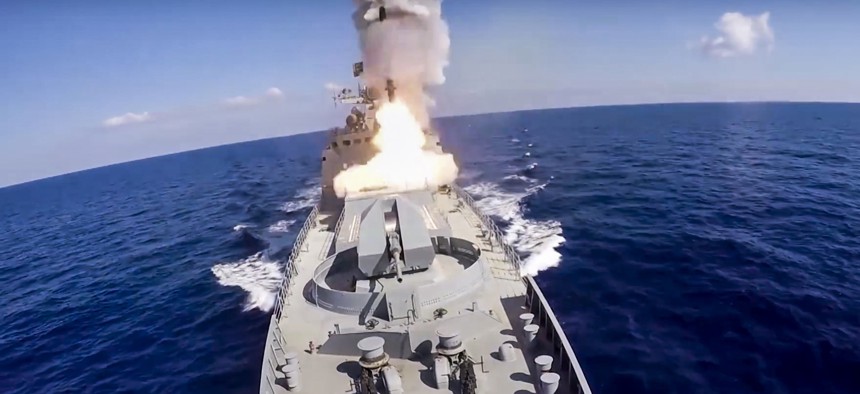
In this image provided by Russian Defense Ministry Press Service and released on Friday, June 23, 2017, long-range Kalibr cruise missiles are launched by a Russian Navy ship in the eastern Mediterranean. Russian Defense Ministry Press Service via AP
How Russia’s Sub-Launched Missiles Threaten NATO’s Wartime Strategy
NATO used to worry that Soviet subs would decimate supply convoys and carrier battle groups. Now Russia can simply wreck ports from afar.
Three years ago, the Russian submarine Rostov-na-Donu wrapped up its sea trials by firing a few test missiles in the Barents Sea. This is not particularly unusual; such tests are sometimes conducted just off the Norwegian coast, close enough to be seen by the NATO ally’s border guards. Nor was it unusual for the newly commissioned attack submarine to head off toward its new homeport, Sevastopol in annexed Crimea, home of Russia’s Black Sea fleet.
The unusual part came in early December, when the improved Kilo-class submarine began to loiter off Syria — and on Dec. 8, unleashed a volley of Kalibr cruise missiles against what Moscow alleged were ISIS targets ashore.
The cruise missile attack itself counted for little in the Syrian civil war, where both Russia and the U.S.-led coalition have been pounding targets from the air with missiles and bombs for years. But it signaled that Russia had joined the small global club that can deliver no-notice long-range strikes from the relative safety of the underwater domain. This technological achievement has game-changing implications for NATO and America’s ability to come to the aid of its European allies if Russia and the transatlantic alliance ever comes to blows in Europe.
During much of the Cold War, NATO planners worried that American reinforcements coming across the North Atlantic in wartime would be savaged by a surge of Soviet submarines and naval bombers. So the alliance developed a barrier strategy around the Greenland-Iceland-UK choke points: find the Soviet subs with ocean-bottom microphones, then stop them with NATO-member frigates, maritime patrol aircraft, and submarines. This scenario is vividly recounted in Tom Clancy’s Red Storm Rising, a Cold War cult classic that is still well worth a read.
Related: Why Didn’t the US Shoot Down That North Korean Missile?
Related: NATO Doesn’t Need 4% Defense Spending
Related: Ukraine is Building a Mosquito Navy to Fend Off Russia, With US Help
Today, however, the Russian navy is too small to sustain an anti-shipping campaign of that magnitude, or to threaten America’s and NATO’s command of the open ocean. But with its new high-quality submarine force, married with the ability to launch cruise missiles, the Russian navy is still in a position to deny access to Europe via the North Atlantic. Northern Europe has surprisingly few seaports and airports through which large amounts of NATO troops and materiel can flow to respond to Russian aggression. They are all well within the estimated 1,500-mile range of Kalibr missiles fired from the Norwegian Sea or the North Sea, all well north of the GIUK gap.
The Kalibr is thought to be somewhat less accurate than the U.S. Tomahawk cruise missile, but packs a warhead that is nearly twice the size. And shutting down a seaport or airport does not require its complete destruction. A reinforcement node requires a range of equipment and infrastructure to operate, including on- and off-loading equipment, storage facilities, and connectors to rail and roads. Seriously damaging these unprotected and fragile components, which are often out in the open, would hamper NATO’s reinforcement efforts across the sea considerably. In short, NATO’s effort to come to the aid of an ally under threat could be over before it even truly begins, and it could end in the North Atlantic rather than in, say, the Suwalki gap or in the face of the much-discussed A2/AD network built by Russia in Kaliningrad. Russia’s ability to launch long-range cruise missiles from submarines also come with a deterrence effect. It could certainly complicate the decision-making in European capitals if national leaders had to also ponder that their own countries, however far away from eastern Europe, were at risk of a Russian strike.
Russia is doubling down on cruise missiles in its navy. Built in Saint Petersburg between 2011 and 2014, Rostov-na-Donu is just one of the Black Sea fleet’s six missile-bearing improved Kilo-class boats. Its 2015 attack on Syria was followed by others, most recently carried out by a pair of improved Kilo-class boats in October 2017. Russian surface warships have also fired cruise missiles against Syria, from waters as far away as the Caspian Sea. Not all cruise missile launches have gone as planned; some of Caspian Sea-fired Kalibrs crashed far short of their targets in northern Iran. But even these failures have provided real-world data and lessons for the Russian navy.
The improved Kilo class is not the only submarine platform for the Kalibr and other long-range missiles. Russia’s new multi-purpose nuclear attack submarine, dubbed the Severodvinsk class, can carry up to 40 Kalibrs, while the upgraded Oscar-II nuclear guided missile submarines can pack up to 70. The two current Severodvinsk boats (more are coming) and the Oscar-IIs currently serve with the Northern Fleet on the Kola Peninsula, within easy reach of the North Atlantic. And in July 2017 Putin signed out new guidance to the Russian military dictating that cruise missiles should become the main armament for the Russian navy in the coming years.
NATO and its members — in particular Norway, the United Kingdom, and the United States — have begun to respond to the re-emerging threat to the reinforcements across the North Atlantic, with investments in maritime patrol aircraft, submarines, and the re-opening of North Atlantic basing. NATO is also re-establishing an Atlantic command of sorts, to be based in Norfolk, Virginia. But this is just a start, and the new contest in the North Atlantic will be different from the one that took place during the Cold War, due to Russia’s shift from quantity to quality in its submarine force and the reliance on cruise missiles for long-range attack against both ships and targets ashore. NATO and its members should, among other things, consider operations and exercises much further north of the GIUK gap, leveraging new technologies that will allow the distribution of sensors across a broad area of the maritime domain, making ports and airfields more resilient and robust, and the bolstering of defenses against cruise missile attacks. It is indeed true that the resurgent Russian navy is not of the size and scope of its Cold War forebear, but it constitutes a high Kalibr threat to the North Atlantic region indeed.




